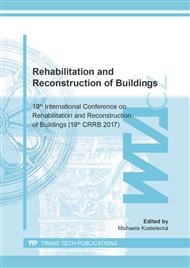[1]
Grzeszczyk, S., Front, K.: Effect of superplasticizers on the rheological properties of fly ash suspensions containing activators of the pozzolanic reaction. Cement and Concrete Research. 30 (2000) 1263-1266.
DOI: 10.1016/s0008-8846(00)00326-4
Google Scholar
[2]
Gołaszewski, J., Szwabowski, J.: Influence of superplasticizers on rheological behaviour of fresh cement mortars. Cement and Concrete Research. 34 (2004) 235-248.
DOI: 10.1016/j.cemconres.2003.07.002
Google Scholar
[3]
Nehdi, M., Rahman, M.: Estimating rheological properties of cement pastes using various rheological models for different test geometry, gap and surface friction. Cement and Concrete Research. 34 (2004) 1993-(2007).
DOI: 10.1016/j.cemconres.2004.02.020
Google Scholar
[4]
Yahia, A.: Effect of solid concentration and shear rate on shear-thickening response of high-performance cement suspensions. Construction and Building Materials. 53 (2014) 517-521.
DOI: 10.1016/j.conbuildmat.2013.10.078
Google Scholar
[5]
Lapasin, R., Papo, A., Rajgelj, S.: Flow behavior of fresh cement pastes. A comparison of different rheological instruments and techniques. Cement and Concrete Research. 13 (1983) 349-356.
DOI: 10.1016/0008-8846(83)90034-0
Google Scholar
[6]
Roussel, N.: Steady and transient flow behaviour of fresh cement pastes. Cement and Concrete Research. 35 (2005) 1656-1664.
DOI: 10.1016/j.cemconres.2004.08.001
Google Scholar
[7]
Baldino, N., Gabriele, D., Lupi, F., Seta, L., Zinno, R.: Rheological behaviour of fresh cement pastes: Influence of synthetic zeolites, limestone and silica fume. Cement and Concrete Research. 63 (2014) 38-45.
DOI: 10.1016/j.cemconres.2014.04.009
Google Scholar
[8]
Covas, J., Maia, J., Machado, A., Costa, P.: On-line rotational rheometry for extrusion and compounding operations. Journal of Non-Newtonian Fluid Mechanics. 148 (2008) 88-96.
DOI: 10.1016/j.jnnfm.2007.04.009
Google Scholar
[9]
Papo, A., Piani, L.: Effect of various superplasticizers on the rheological properties of Portland cement pastes. Cement and Concrete Research. 34 (2004) 2097-2101.
DOI: 10.1016/j.cemconres.2004.03.017
Google Scholar
[10]
Paiva, H., Silva, L., Labrincha, J., Ferreira, V.: Effects of a water-retaining agent on the rheological behaviour of a single-coat render mortar. Cement and Concrete Research. 36 (2006) 1257-1262.
DOI: 10.1016/j.cemconres.2006.02.018
Google Scholar
[11]
Gad, E.A.M., Mabrouk, M.R., Mosallamy F.H.: Rheological properties of different cement pastes made with different admixtures, Silicicate Industriels. 70 (2005) 59-64.
Google Scholar
[12]
Vikan, H., Justnes, H.: Rheology of cementitious paste with silica fume or limestone. Cement and Concrete Research. 37 (2007) 1512-1517.
DOI: 10.1016/j.cemconres.2007.08.012
Google Scholar


